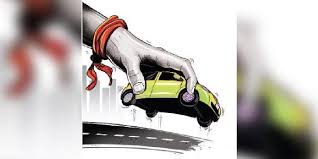The congestion on roads hits travelers’/drivers health, especially their mental health and this triggers road rage.
Street Talk
Expert Opinion

A recent tragic road accident in the heart of Srinagar city that consumed a few lives of minor boys has ignited a debate around parenting responsibilities. At the same time, the traffic police department swung into action and intensified its drive against minors driving two-wheelers and four-wheelers. Amid this action-and – reaction scenario, common people took to their social media handles, criticizing the parents who allow their minor wards to drive vehicles and at the same time appreciating the traffic police for crackdown on traffic rule violators, especially seizing the vehicles driven by minors on the roads. In the overall situation, the traffic police department capitalized on the dreadful accident and tried to paint a rosy picture of itself in terms of their performance on roads and conveniently took a dig at general commuters/drivers for lack of discipline on roads.
Road accidents involving minors can be dubbed stray incidents when compared with the overall rate of accidents happening on the Jammu & Kashmir roads. Such accidents have happened in the past and will happen in future also. At the moment, launching a crackdown on traffic rule violators is by all means a reactionary act and is bound to lose steam after a couple of weeks or so. In fact such reactions are nothing but applying a Band-Aid to a deep wound which does not serve any purpose!
Actually, the problem of the growing rate of road accidents is not that under-age boys and girls are driving vehicles. The problem lies with the system – the traffic management system. The management of roads and road-intersections is a huge issue and lack of professional personnel trained in handling traffic has complicated the mess on roads. The massive traffic jams, precisely congestion, on main roads, feeder roads, even in lanes and by-lanes, have become a norm at our place. This heavy congestion on roads is the basic cause of road accidents as this triggers road rage. Let us understand that traffic jams have a huge ripple effect impacting our countless aspects of travel and life. In other words, this congestion bears consequences of economic losses and adversely hits travelers’/drivers health, especially their mental health.
Let me explain.
Who would like to be stuck on a heavily congested road? Of course, no one. It is always inconvenient and frustrating to get locked in a traffic jam, especially when you have an urgent need to reach your destination. In economic terms, it negates the proverb: Time is money. For instance, a distance which normally takes twenty minutes to travel is completed in one hour or more due to traffic jams, wasting precious time of the commuters/drivers. It lowers their working hours, scales down productivity and earnings at the end of the day. However, economic losses apart, the significant ripple effect of congestion on roads, as already stated above, negatively impacts countless aspects of our life.
The more congestion experienced by the drivers, the more frustrated they become, leading to road rage. When a driver is late for work or gets frustrated with traffic jams, he is bound to begin to exhibit dangerous driving behaviors. He may resort to speeding, cutting other drivers off, or tailgating and all of these actions lead to road rage and significantly endanger other commuters on the roads. This road rage carries highest safety risks for all and if the authorities give a proper thought to find out the major cause of accidents, they will find this congestion-induced road rage as the main culprit.
The most important observation is that congestion-induced road rage immediately takes the attention of drivers from the road. In this situation, drivers maneuver their vehicles into small spaces and during the course, they lose sight of the road ahead. Consequently, they get more likely to rear-end or hit another vehicle. In other words, during aggressive driving patterns in post-congestion driving, the drivers become less focused on the dashboard area. The Thar accident in Tengpora area of Srinagar city, which claimed a few lives of school-going children in the vehicle, is a perfect example of road rage in which they lost sight of the road ahead and collided with a stranded vehicle.
A driving simulation study is worth quoting. The study has found that driver behavior in post-congestion situations became more aggressive, more focused in the forward area but less focused in the dashboard area, and was associated with lower power of the β-band in the temporal brain region. The clustering results, as per the study, showed more aggressive and lack-of-aware response patterns while driving in post-congestion situations.
So, the negative influence of traffic congestion on the mental health of drivers is a dangerous aspect and it is this factor which has been taking the toll of lives in road accidents.
Precisely, the ripple effect that congestion has on our place is immense and acutely distressing. The need of the hour is to integrate advanced technology in the traffic management system with real-time traffic monitoring and traffic control technology, at least in the twin cities of Jammu and Srinagar. This way, the traffic department can capture credible traffic data to be turned into traffic analytics. These analytics will help to capture real-time detection, classification, and traffic tracking and ultimately this will contribute to efficient traffic management to prevent congestion on roads efficiently. Consequently, it will make travel safer and more efficient for drivers and commuters. Ultimately, the rate of accidents will come down and a positive ripple effect of productivity, efficiency, and safety can also be cultivated.
To conclude, the general public cannot escape from their responsibility to help in removing the mess on our roads. Generally, it is a common sight to observe that people are glad to resort to on-street parking contraventions even on busy roads and block smooth traffic movement. There is also no concept of bus stops, though many bus stops exit at various points. Passenger vehicles hardly use bus stops. It is not the driver alone to be blamed for this. But the fact is that people never wait for a passenger bus at a bus stop. The understanding between the driver and the passenger has gone trendy that they know the bus can stop anywhere anytime for him at the cost of smooth traffic movement.
Let the people understand that we cannot afford to lock our future to these gridlocks. We have to seriously pull ourselves out of this mess and we need tocchallenge conventional thinking around traffic congestion.
Meanwhile, let me reiterate that time demands to rope in traffic engineers who are technically trained to develop traffic engineering plans; ensure proper traffic specifications; estimate traffic levels, and traffic control; and create traffic signal reports. They are the professionals who use computer simulations to test various traffic scenarios before implementing changes on streets and highways.
(The author is a veteran journalist/columnist. He is former Head of Corporate Communication & CSR and Internal Communication & Knowledge Management Departments of J&K Bank)


